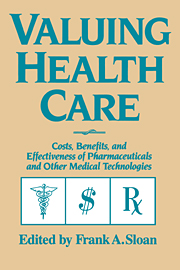 Valuing Health Care
Valuing Health Care Published online by Cambridge University Press: 07 December 2009
Programs in health care have varying objectives. The objective of prenatal care might be a reduction in infant mortality. Rheumatologists strive to make their patients more functional, whereas primary care providers often focus on shortening the cycle of acute illness. All of these providers are attempting to improve the health of their patients. However, they each measure health in a different way. Comparing the productivity of a rheumatologist with that of a neonatologist may be like comparing apples to oranges.
The diversity of outcomes to health care has led many analysts to focus on the simplest common ground, typically, mortality or life expectancy. Those who are alive are statistically coded as 1, and those who are dead are statistically coded as 0. Mortality allows the comparison between different diseases. For example, we can state the life expectancy of those who will eventually die of heart disease and compare it to the life expectancy of those who eventually die of cancer. The difficulty is that everyone who remains alive is given the same score. A person confined to bed with an irreversible coma is alive and is counted the same as someone who is actively playing volleyball at a picnic. Utility assessment, on the other hand, allows the quantification of levels of wellness on the continuum anchored by death and optimum function.
This chapter reviews the concept of utility in relation to the evaluation of cost–effectiveness of pharmaceutical products.
To save this book to your Kindle, first ensure [email protected] is added to your Approved Personal Document E-mail List under your Personal Document Settings on the Manage Your Content and Devices page of your Amazon account. Then enter the ‘name’ part of your Kindle email address below. Find out more about saving to your Kindle.
Note you can select to save to either the @free.kindle.com or @kindle.com variations. ‘@free.kindle.com’ emails are free but can only be saved to your device when it is connected to wi-fi. ‘@kindle.com’ emails can be delivered even when you are not connected to wi-fi, but note that service fees apply.
Find out more about the Kindle Personal Document Service.
To save content items to your account, please confirm that you agree to abide by our usage policies. If this is the first time you use this feature, you will be asked to authorise Cambridge Core to connect with your account. Find out more about saving content to Dropbox.
To save content items to your account, please confirm that you agree to abide by our usage policies. If this is the first time you use this feature, you will be asked to authorise Cambridge Core to connect with your account. Find out more about saving content to Google Drive.